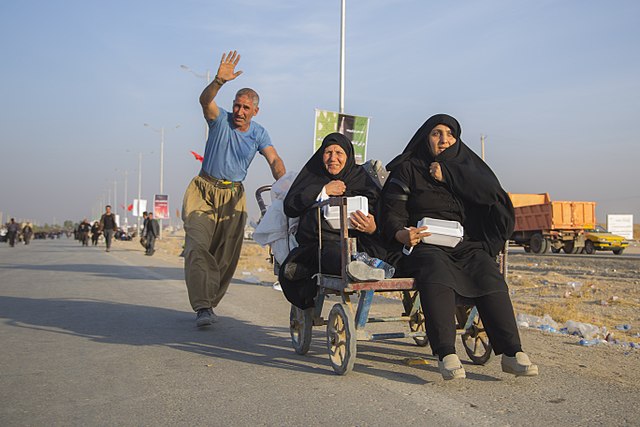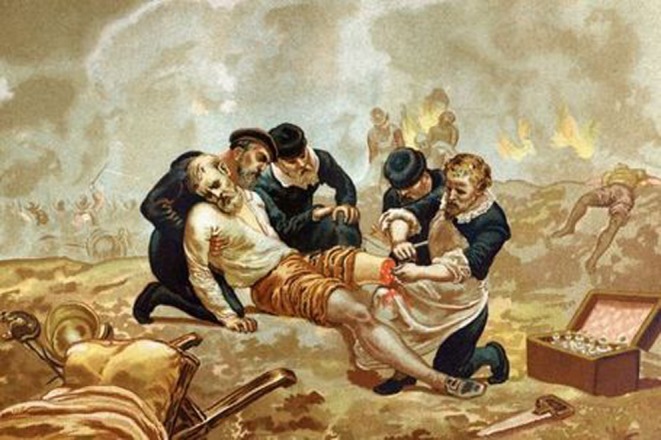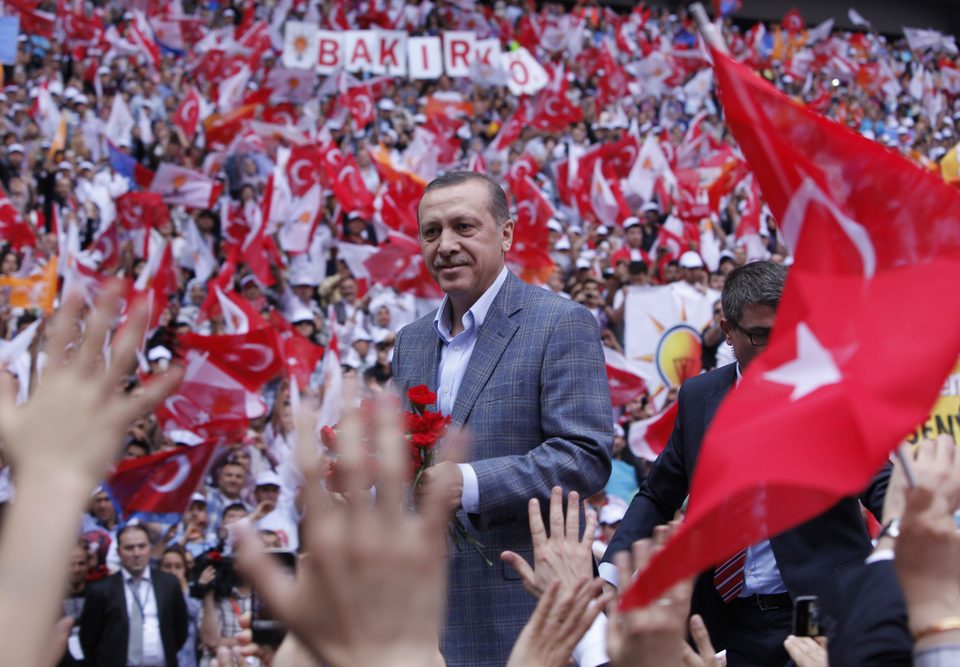


Migrant Labor: Policies Serving Production Systems
16 November 2020
Migration, Diversity & Mobility
18 November 2020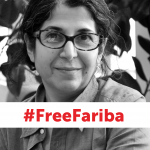
Our colleague, CERI researcher Fariba Adelkhah, has considered mobility as a key research area. Her most recent work focused on the circulation of Shiite clerics between Afghanistan, Iran, and Iraq. She would certainly have contributed to this issue if she were able to freely express herself today. This is not the case.
After being arrested in Tehran in June 2019 on the pretext of false accusations, she was sentenced to 5 years in prison. She was recently placed under house arrest with her relatives for sixteen months, but was not allowed to write or even read during her detention. Even though she was able to write and translate poems, she did not and still does not have access to books she might want to read in social sciences, and in prison she did not always have paper or a pencil. In any case, she would not have had the right to release any writings from prison, especially in French. Despite these undignified conditions, and while sharing a cell with around forty prisoners, Fariba never gave up: after a hunger strike in the name of academic freedom, she worked for months in the prison library and produced paintings made of scraps of leather. Learn more here.
For lack of a better option, and without claiming to speak for her, we would like to help you discover or rediscover one of her books: “The Thousand and One Borders of Iran‘”(Routledge, 2019)(1)initially published in French: Les mille et une frontières de l’Iran : quand les voyages forment la nation, 2012, Éditions Karthala. We included some long excerpts here so that you can appreciate the depth, exuberance, and sensitivity of this story.
An Anthropological Approach to Iranian Mobility
 An anthropologist of post-revolutionary Iran and its transformations, Fariba Adelkhah questions the Iranian national construct from both the inside and outside. In this book, as she follows Iranians in their travels, she is less interested in the classical questions of demographic, social, and political factors and constraints shaping travel, than in the continuity of social transformations outside of national borders. In other words, she is neither focusing on emigration and immigration, and the relationship between so-called “sending” and “host” societies, nor on the Iranian “diaspora”, globalisation processes, and transnational practices, but rather on the specific experience of the journey that” “creates its own social effects, for example in terms of gender relations as well as relations between social classes, between statuses, between ethnic and faith groups, and between travellers and locals.”
An anthropologist of post-revolutionary Iran and its transformations, Fariba Adelkhah questions the Iranian national construct from both the inside and outside. In this book, as she follows Iranians in their travels, she is less interested in the classical questions of demographic, social, and political factors and constraints shaping travel, than in the continuity of social transformations outside of national borders. In other words, she is neither focusing on emigration and immigration, and the relationship between so-called “sending” and “host” societies, nor on the Iranian “diaspora”, globalisation processes, and transnational practices, but rather on the specific experience of the journey that” “creates its own social effects, for example in terms of gender relations as well as relations between social classes, between statuses, between ethnic and faith groups, and between travellers and locals.”
Exploring travel as a “social fact”, she discusses Iran and its society; through the anthropology of travel, she studies Iran, its social transformations, and nation building from the outside. And to explain the contrast, if not contradiction, between the “centrality in history of the social practice of travel and Iran’s openness to the world, on the one hand, and, on the other, the omnipresence of a suffering, ethnocentric, and proud narrative of the “oldest” of nations, she borrows from history and from the anthropology of religions, family, youth, and male-female relationships.
Thus, the book begins with an account of a women’s pilgrimage to Damascus, which she joined in 2002.
The Pilgrimage: A Mirror of the Social Transformations in Iran
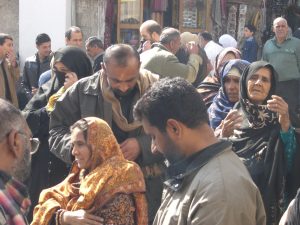
Pèlerins chiites devant la Grande mosquée de Damas, février 2008. Crédits Sibir
Pilgrimages provide a prime window into Iranian mobility, and thus into the history of Iran. As a religious and transnational practice, the pilgrimage abroad conveys a “moral economy of the State and of the nation”: the pilgrimage “reflects some ethical values and some practices that appear to be inseparable from the historical experience of Iranian society in the Islamic Republic.” These values and practices include the following ones that Fariba Adelkhah describes in her field notes:
“The first obvious factor relates to the social empowerment of women: it is an absolutely unprecedented phenomenon to see them travel, develop specific forms of worship and engage in trade independently of their husbands – abroad as well as in their own country. Another striking feature is the individuation of the pilgrims, irrespective of their sex or age. They travel essentially as individuals, leaving behind the entity of the family, which of course does not exclude the fact that they may possibly be accompanied by a member thereof, nor the fact that they remain in constant contact with those who have remained in the home country, by phone or by their emotional attachments. Third, religious experience, while keeping its transcendence and its irreducibility, goes along with the all-pervasiveness of rational economic calculation: the sacred realm and the business sphere are found side by side though they never entirely merge, and the pilgrim, absorbed in his devotions, spends a crucial part of his trip implementing his business strategy. Fourth, pilgrimage brings travellers face to face with the unknown abroad, and introduces an element of relativisation and self-reflexivity into the national consciousness: geographical and linguistic unfamiliarity, separation from friends and relatives, unexpected events on the journey – these represent a change in social scale and here too introduce again a break with past practices. This is especially true as the experience of religious pilgrimage fits into the growing experience of economic expatriation and fits into the circuits of the diaspora. Finally, if the journey continues to be a source of knowledge, wisdom and distinction, even more so today than in ancient times, it is legitimised by the religious purpose of the pilgrimage that to some degree ‘purifies’ the intentions of those who set off, and who might always be suspected of engaging in economic activities of reprehensible pleasures.”
The Pilgrimage as Empowerment
Of all these travel experiences, which extend and fuel the transformations of Iranian society, let us dwell on the first aspect – women’s social empowerment – because it is the one that Fariba Aldelkhah chose to begin her book.
“Nothing is less “traditional” than this pilgrimage to Damascus. Besides the fact that it is, after all, of recent creation, it signals one of the major changes in Iranian society over the last 20 years. Once upon a time, the pilgrimage to Mecca was made almost exclusively by men and indeed community leaders, and the one to Mashhad was entirely a family business. Today, both young people and women also take to the roads to venture thousands of miles from home, not only in international space but also outside the family framework that once constituted pilgrimages. In other words, the practice of pilgrimage has been democratised, although it remains a criterion of social distinction. And from this point of view, the pilgrimage in Syria is particularly revealing of this transformation. Women are its cornerstone, both as believers accomplishing religious duties and as organisers. The initiative for setting out frequently lies within the jalaseh, the religious meetings of women which have proliferated since the revolution. In buses and in shrines themselves, chadors in black or with a flowery pattern predominate. This can be explained quite simply by the fact that women have fewer work commitments, and therefore more opportunities to get away for a fortnight. However, this interpretation is not altogether satisfactory – women also have more family and household responsibilities – and does not pinpoint the essential factor, namely the social significance of the journey itself. Thanks to this journey, women can assert themselves in the public space, acquire specific know-how, develop their own forms of sociability, burst onto the international or at least regional scene, change the social relations within families and neighborhoods, accumulate capital or independent income through the street trading in which they can indulge during the pilgrimage.”
The Pilgrimage, a Commercial Space
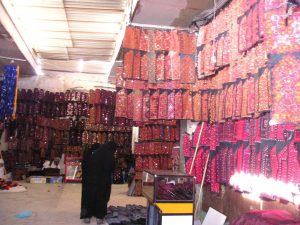
Bazar baloutche, Zahedan. Crédit photo : Fariba Adelkhah
Fariba Adelkhah describes the female guides and organisers who lead this two-week trip, including four bus days to get there and four to get back.
“Consider the case of Haj Khanum, for example. Married to a grocer and occasionally serving in the shop, she organises religious meetings in her home. This is where she recruits most of the female pilgrims accompanying her to Damascus, while others hear about it by word of mouth. The pilgrimage in which we participated was Haj Khanum’s seventeenth trip. But she also organises journeys within Iran, especially to visit the hot springs, reputed to be full of healing powers, at Sareine in the province of Ardabil. Sometimes she works in a joint venture with the agency, and in this case she relies on it for everything related to logistics, including obtaining a Syrian via. Sometimes she hires a bus for herself, when enough pilgrims register, and then handles the material organisation of the trip. As we have seen, the pilgrimage in which we took part was an example of the first case. However, Haj Khanum exercised a definite authority in our small community, derived from her experience and the 20 or so pilgrims she had brought along to the agency in return for two free places for herself. According to some of the women travellers, she had on a previous trip directed the driver to turn back about 40 km to take breakfast on the shores of Lake Van, in accordance with her own habits and for the pleasure of the passengers. Basking in her ascendancy, she kept up a veiled rivalry with the guide, not failing to point out that her husband would have done it better if he had been there, and handing out instructions to the crew without much restraint. Camping at the back of the bus with her travelling companions, she had arranged a sort of berth in which she could sleep, covered by her chador, while other passengers had to grab forty winks curled up on their seats. She bustled among the (masculine) crew, unabashedly handing round the meals. But of course her main job, where she excelled more than in religious matters, due to her lack of education, was informal trade to which she was devoted and which was her main preoccupation. She had first managed to ensure the agency stock up with provisions for the pilgrims from her husband’s grocery. Then, in the two main cities where purchases for the venture were obtained, Damascus and Gaziantep, she endeavoured to procure the goods which she had been asked to obtain in Tehran. So she went by collective taxi, via a stopover, to Bab Touma, the eastern gate of Damascus, to find a nightgown and a pair of luxury shoes whose quality contrasted with the Chinese products for sale round Zeynabiyeh. Finally, she bought a few packets of nasal dressings which are all the rage in Tehran among girls who want to give the impression that they have undergone cosmetic surgery – for the ways of social distinction are inscrutable! In addition, in Zeynabiyeh, when the afternoon reserved for shopping came, the guide took care to point out, with some emphasis, to the tenants of two stores, one selling cosmetics, the other chocolates, that the travellers were Haj Khanum’s – Haj Khanum is the guide (mo’allem) – thus implying that the commission should be paid to her. And, in our hotel, Haj Khanum invited a seller of shirts and scarves who also offered her if not a percentage, at least a gift. These notes are sufficient to establish that pilgrimage can take a woman such as Haj Khanum not only out of her traditional role, but also out of the role of being the organiser of jaleseh, and extending it beyond the neighborhood. In this context, she behaves as the equal of a man and as an entrepreneur operating in the international sphere.”
When the Story of Daily Life Reveals the Society
Thanks to her earthy descriptions, Fariba Adelkhah makes us travel with these women and allows us, at the end of her story, to better grasp her analysis:
“In fact, throughout the trip, an almost complete reversal of roles could be witnessed. These were men who did the cooking, washed the dishes, and did the shopping, while the women, as passengers, tourists and members of the faithful, were served on, had fun, and indulged in the joys of shopping and the giddy delights of trade. Back home, they would also be able to shine in society, boasting of having done nothing other than ‘eat and sleep for a fortnight’, recounting the adventure, recognising on the television the places they had visited, watching the inevitable videos with their families, and staying in touch with the woman they have been on pilgrimage with. It is indeed a ‘summer holiday’ atmosphere that the trip to Damascus created, with a hangover on the return journey or a longing to return to the humdrum life of Tehran. Nevertheless, what is left is the narrative, and this alone is the bearer of a transformation in the social condition of women.”
By starting her book with a description of women, Fariba Adelkhah emphasises both the importance of women in the Iranian revolution and the importance of the revolution for women (the subject of her initial academic research and of her doctoral thesis published in 1991: La révolution sous le voile : femmes islamiques d’Iran [The revolution under the veil: Islamic women in Iran] (Paris: Éditions Karthala), while also contributing to the numerous research projects that have made women visible in international mobility.
We impatiently await Fariba’s liberation so that we can continue the very rich conversation started in her book The Thousand and One Borders of Iran, and she can continue her research, including the work she started on the circulation of Shiite clerics in Afghanistan, Iran, and Iraq.
By Hélène Le Bail and Hélène Thiollet, researchers at Sciences Po’s Center for International Researches (CERI)
“Selective” bibliography
- ADELKHAH, Fariba « Les madrasas chiites d’Afghanistan » Shiite madrasas in Afghanistan] In La cité cultuelle, edited by Jean-François LEGUIL-BAYART and Ariane ZAMBIRAS, 43–73. Karthala, 2015
- ADELKHAH, Fariba, ed. « Guerre et terre en Afghanistan » [War and land in Afghanistan], Revue des mondes musulmans et de la Méditerranée, June 2013
- ADELKHAH, Fariba. Les paradoxes de l’Iran. [The paradoxes of Iran], Éditions Le Cavalier Bleu, 2013
- ADELKHAH, Fariba, and Keiko SAKURAI, eds. The Moral Economy of the Madrasa. Islam and Education Today. Routledge, 2011
- LEGUIL-BAYART, Jean-François, and Fariba ADELKHAH, eds. Voyages du développement. Émigration, commerce, exil. [Development travel. Emigration, trade, and exile] Karthala, 2007
See all of Fariba Adelkhah’s publications
Notes
| ↑1 | initially published in French: Les mille et une frontières de l’Iran : quand les voyages forment la nation, 2012, Éditions Karthala |
|---|

